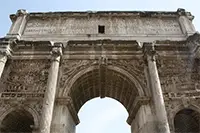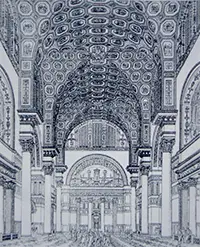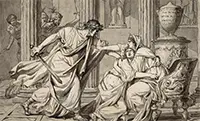The Rise and Fall of the Roman Empire
Part 6: Imperial Crises The Praetorian Guard handed the throne to a soldier named Pertinax. He agreed to take the throne and set about trying to undo some of the damage done by Commodus. The one important thing that he didn't do was give a large sum of money to the Praetorian Guard, who had put him on the throne. After 86 days of waiting, several dozen of the Guard rushed the palace and killed Pertinax where he stood. Next on the throne was the person who paid the most money to the Praetorian Guard for the privilege. This was Didius Julianus (right), a In response, three powerful generals declared themselves free of their responsibilities to serve this new emperor and, further, declared themselves the rightful occupant of the throne. Pescennius Niger was governor of Syria. Clodius Albinus was commander in Britain. Septimius Severus was commander in Pannonia. Each of these generals had three legions, and each announced his intention to march on Rome and take the throne. In the chaos that ensued, Severus emerged victorious and took the throne. 
Now that he had conquered his rivals, Severus turned to fighting Rome's external enemies. In yet another struggle against the Parthians, Severus relieved the siege of Nisibis in Mesopotamia and then took the fight to Parthia itself, sacking Babylon and Seleucia and, ultimately, Ctesiphon, the capital. After an aborted attempt to take the fortress of Hatra, he sued for peace and declared victory in the East, taking the title of Parthicus Maximus and creating a new Province of Roman Mesopotamia. As part of its gratitude, the Senate granted him the construction of a Trumphal Arch (which still stands). Rather than return to Rome, Severus continued on campaign, marching his troops in Egypt and restoring order there. He spent a year in Syria before News of fighting on the frontier in Brittania prompted Severus to lead troops into battle there. In addition to pacifying the Caledonians (and taking the title Brittanicus), he oversaw the repair and renovation of Hadrian's Wall. He was on campaign there when he died, in 211. He had declared that both of his sons, Caracalla and Geta, should succeed him as co-emperors. Their first act was to end the fighting in Britain, returning the border to Hadrian's Wall. They returned to Rome but could not agree on how to share power or even on how to make basic political decisions, like appointing government officials. (The one thing they did agreed on, a geographical division of the Caracalla led troops into battle in the east, betraying the trust of the Parthians and then crushing them and then targeting the Medes. The unpopular emperor made an enemy of Macrinus, his Praetorian Prefect, who had him killed on the side of a road in 217. For all his cruelty, Caracalla did make two lasting positive contributions to the Roman legacy. In an Edict of 212, he declared the Constitutio Antoniniana, or Antonine Constitution, which gave to all men living freely in the Empire the status of full Roman citizenship. Critics have argued that it didn't hurt that having more citizens on the tax rolls could generate more revenue for a royal treasury that was sorely lacking. At the same time, it was still a stroke of equality that instantly made Roman citizens of a great many people who could only dream of such a status. 
His other lasting contribution was the construction of a very large baths complex. Building began in 211, at the start of his reign, and the inauguration came in 216. Completion of the original design came two decades after construction began. Covering 62 acres, they were the Empire's second-largest bath complex and could accommodate up to 8,000 bathers a day. The complex also had other buildings, such as a library, and areas for other physical activities, such as walking and other forms of exercise. Next page > Geography and Power-sharing > Page 1, 2, 3, 4, 5, 6, 7, 8, 9 |
|
Social Studies for Kids
copyright 2002–2024
David White



 wealthy Senator. He, too, had a lengthy record of service, including serving as consul along with Pertinax in 175. He fought in Germany and later served as proconsul of North Africa. His "purchase" of the throne was widely known, and he was sometimes greeted with jibes by a public that wanted nothing so much as honor and stability from their emperor, something that they had as recently as 180, in the reign of
wealthy Senator. He, too, had a lengthy record of service, including serving as consul along with Pertinax in 175. He fought in Germany and later served as proconsul of North Africa. His "purchase" of the throne was widely known, and he was sometimes greeted with jibes by a public that wanted nothing so much as honor and stability from their emperor, something that they had as recently as 180, in the reign of  finally returning to Rome, in the summer of 202. He returned to his hometown later that year and ordered new construction, of monuments and a basilica and a forum and a harbor. He had brought soldiers with him, of course, and they busied themselves seeing off incursions by desert tribes such as the Garamantes who had been raiding settlements. He toured the former Carthaginian power centers of Carthage and Utica, shoring up the frontier, and then went back to Italy in 203. He stayed in Rome for five years.
finally returning to Rome, in the summer of 202. He returned to his hometown later that year and ordered new construction, of monuments and a basilica and a forum and a harbor. He had brought soldiers with him, of course, and they busied themselves seeing off incursions by desert tribes such as the Garamantes who had been raiding settlements. He toured the former Carthaginian power centers of Carthage and Utica, shoring up the frontier, and then went back to Italy in 203. He stayed in Rome for five years. empire, was vetoed by their mother, whom they still revered.) Each had his own group of support, and tensions ran high. Their mother tried to keep the peace, but both brothers were obstinate and eventually sought to become sole ruler. Antoninus succeeded in this on Dec. 26, 211, having his brother murdered in the midst of a family gathering; Geta died in his mother's arms. Antoninus then ordered a purge of a great many of Geta's supporters. In a final act of supreme kindness, he ordered his brother's name and image stricken from official written accounts of the state. His face disappeared from coins and paintings. Statues of him were struck down. Even speaking his name was a capital offense.
empire, was vetoed by their mother, whom they still revered.) Each had his own group of support, and tensions ran high. Their mother tried to keep the peace, but both brothers were obstinate and eventually sought to become sole ruler. Antoninus succeeded in this on Dec. 26, 211, having his brother murdered in the midst of a family gathering; Geta died in his mother's arms. Antoninus then ordered a purge of a great many of Geta's supporters. In a final act of supreme kindness, he ordered his brother's name and image stricken from official written accounts of the state. His face disappeared from coins and paintings. Statues of him were struck down. Even speaking his name was a capital offense.
